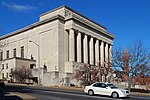Tuckerman Hall
Buildings and structures in Worcester, MassachusettsConcert halls in MassachusettsCulture of Worcester, MassachusettsEvent venues on the National Register of Historic Places in MassachusettsFederal architecture in Massachusetts ... and 5 more
Historic district contributing properties in MassachusettsMusic venues completed in 1902NRHP infobox with nocatNational Register of Historic Places in Worcester, MassachusettsTourist attractions in Worcester, Massachusetts

Tuckerman Hall is a concert hall in Worcester, Massachusetts. It was built in 1902 in the Neoclassical style and restored in 1999. The architect was Josephine Wright Chapman. It is the home of the Massachusetts Symphony Orchestra. Other current uses include weddings, receptions and other events.
Excerpt from the Wikipedia article Tuckerman Hall (License: CC BY-SA 3.0, Authors, Images).Tuckerman Hall
Salisbury Street, Worcester
Geographical coordinates (GPS) Address External links Nearby Places Show on map
Geographical coordinates (GPS)
| Latitude | Longitude |
|---|---|
| N 42.27325 ° | E -71.801277777778 ° |
Address
Tuckerman Hall
Salisbury Street
01605 Worcester
Massachusetts, United States
Open on Google Maps











